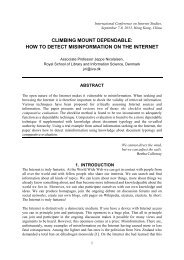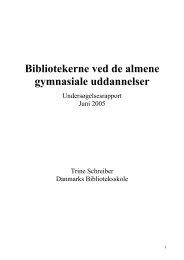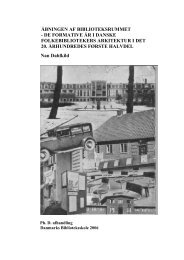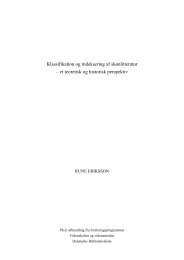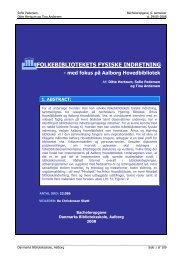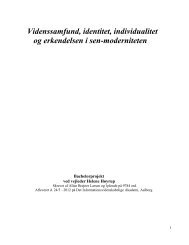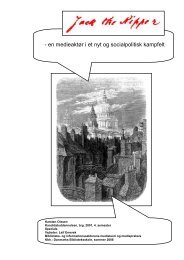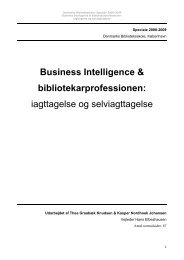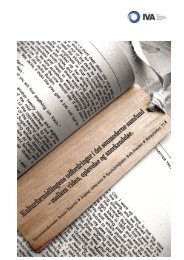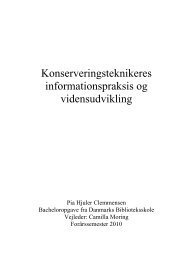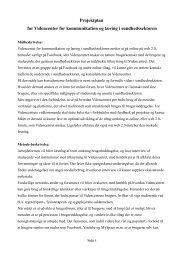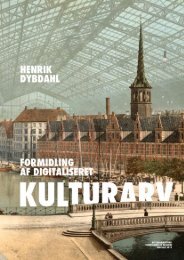Hvorfor er det sjovt at surfe på nettet? - Forskning
Hvorfor er det sjovt at surfe på nettet? - Forskning
Hvorfor er det sjovt at surfe på nettet? - Forskning
You also want an ePaper? Increase the reach of your titles
YUMPU automatically turns print PDFs into web optimized ePapers that Google loves.
5. DISKUSSION OG PERSPEKTIVERING<br />
62<br />
Und<strong>er</strong>holdende int<strong>er</strong>netsøgning<strong>er</strong> – S<strong>er</strong>ena Borsello<br />
Dette kapitel <strong>er</strong> opdelt i to sektion<strong>er</strong>. I den første sektion (§ 5.1) diskut<strong>er</strong><strong>er</strong> jeg<br />
result<strong>at</strong><strong>er</strong> af analysen. Jeg rel<strong>at</strong><strong>er</strong><strong>er</strong> result<strong>at</strong><strong>er</strong>ne til Elsweil<strong>er</strong>, Wilson og Kirekegaard‐Lunns<br />
([in press]) model for casual leisure s<strong>er</strong>ch og an<strong>det</strong> relevant teori. Jeg sammenlign<strong>er</strong><br />
d<strong>er</strong>udov<strong>er</strong> und<strong>er</strong>holdende int<strong>er</strong>netsøgning<strong>er</strong> med købeadfærd og lystlæsning. Som result<strong>at</strong><br />
af denne diskussion forslår jeg en visualis<strong>er</strong>ing af und<strong>er</strong>holdende int<strong>er</strong>netsøgning<strong>er</strong>, d<strong>er</strong> <strong>er</strong><br />
inspir<strong>er</strong>et af Dörk, Sheelagh og Williamsons (2011) flaneur‐metafor og B<strong>at</strong>es (1989)<br />
b<strong>er</strong>rypicking‐model. I den anden sektion (§ 5.2) diskut<strong>er</strong><strong>er</strong> jeg begrænsning<strong>er</strong> af min<br />
analyse, peg<strong>er</strong> <strong>på</strong> mulige forskningsretning<strong>er</strong> og giv<strong>er</strong> eksempl<strong>er</strong> <strong>på</strong>, hvordan<br />
und<strong>er</strong>holdende element<strong>er</strong> kan blive implement<strong>er</strong>ede i systemdesign.<br />
5.1. Und<strong>er</strong>holdnede int<strong>er</strong>netsøgnign<strong>er</strong> og casual leisure search<br />
Jeg vil starte med <strong>at</strong> diskut<strong>er</strong>e, hvordan de opstillede hypotes<strong>er</strong> rel<strong>at</strong><strong>er</strong><strong>er</strong> sig til de<br />
karakt<strong>er</strong>istika af casual leisure‐ søgning<strong>er</strong> identific<strong>er</strong>ede af Elsweil<strong>er</strong>, Wilson og<br />
Kirekegaard‐Lunn ([in press]). Formålet <strong>er</strong> <strong>at</strong> se, hvordan <strong>det</strong> anvendt mediepsykologiske<br />
p<strong>er</strong>spektiv bidrag<strong>er</strong> til forståelse af årsag<strong>er</strong> til, formål med, og måden hvor<strong>på</strong>,<br />
und<strong>er</strong>holdende int<strong>er</strong>netsøgning<strong>er</strong> bliv<strong>er</strong> foretaget.<br />
Årsag<br />
Analysen har identific<strong>er</strong>et to situ<strong>at</strong>ion<strong>er</strong>, d<strong>er</strong> kan give anledning til und<strong>er</strong>holdende<br />
int<strong>er</strong>netsøgning<strong>er</strong>: stress og kedsomhed (§ 4.2.2.). Kedsomhed kan rel<strong>at</strong><strong>er</strong>es til Elsweil<strong>er</strong>,<br />
Wilson og Kirekegaard‐Lunns ([in press]) ”time wasting” scenario; både stress og<br />
kedsomhed <strong>er</strong> af Elsweils<strong>er</strong>, Wilson og Kirekegaard‐Lunn givet som årsag<strong>er</strong> til, <strong>at</strong> indivi<strong>det</strong><br />
involv<strong>er</strong><strong>er</strong> sig i et casual inform<strong>at</strong>ionscenarie.<br />
Disse to årsag<strong>er</strong> bag casual leisure search kan være rel<strong>at</strong><strong>er</strong>et til de to måd<strong>er</strong> <strong>at</strong> bruge<br />
fritid <strong>på</strong>, indentific<strong>er</strong>ede af Martison, Schwarts og Vaughan (2002, s. 43‐44) i forhold til<br />
kvind<strong>er</strong>nes fritidsaktivitet<strong>er</strong>. Forf<strong>at</strong>t<strong>er</strong>ne konklud<strong>er</strong><strong>er</strong> , <strong>at</strong> kvind<strong>er</strong> brug<strong>er</strong> d<strong>er</strong>es fritid, og<br />
comput<strong>er</strong>en, enten til <strong>at</strong> slappe af ell<strong>er</strong> til <strong>at</strong> blive stimul<strong>er</strong>ede. Jeg vil h<strong>er</strong> cit<strong>er</strong>e forf<strong>at</strong>t<strong>er</strong>nes<br />
beskrivelse af disse to måd<strong>er</strong>, <strong>at</strong> bruge fritid <strong>på</strong> fordi de har ligning<strong>er</strong> med henholdsvis <strong>det</strong><br />
passive og <strong>det</strong> aktive int<strong>er</strong>netbrug som analysen tyd<strong>er</strong> <strong>på</strong>, und<strong>er</strong>holdende int<strong>er</strong>netsøgning<strong>er</strong><br />
kan give anledning til. ”<br />
When described as mental stimul<strong>at</strong>ion, leisure was defined<br />
as fun, engaging, ent<strong>er</strong>taining, and sometimes challenging. When<br />
described as recup<strong>er</strong><strong>at</strong>ion, leisure was defined as convenient, easy,



